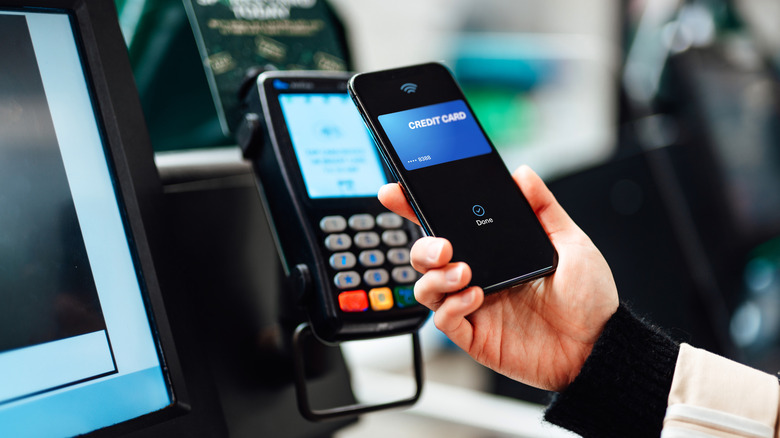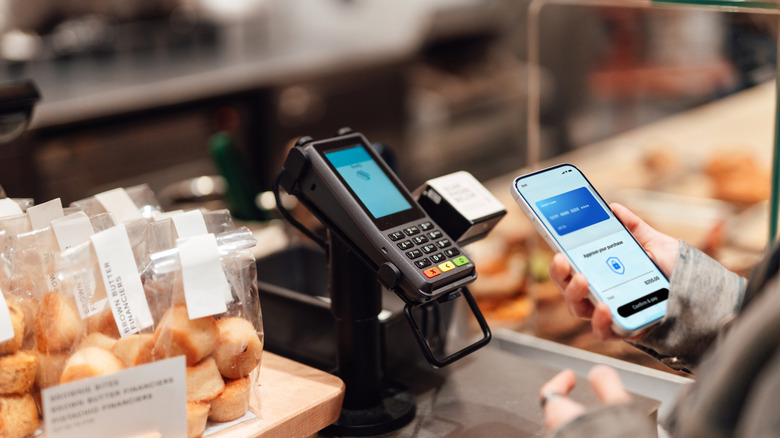Using Tap-To-Pay Often? Here's How Your Transactions Are Kept Safe & Secure
Cashless payments have come a long way since American Express introduced its plastic credit card in 1959. For modern consumers, two factors are at a premium when choosing a payment method, convenience and security, both of which have caused contactless tap-to-pay systems to rocket in popularity. They are powered by near field communication, or NFC technology, in which payment systems like mobile wallets transmit a radio frequency identification (RFID) signal with a one-time use transaction token, ensuring the security of your purchase by eliminating fraudsters' ability to repurpose the transaction data.
Tap-to-pay harkens back to South Korea's 1995 UPass system, in which riders could tap payment terminals to pay for their rides on public transit. In the years that followed, public services and companies ranging from gas stations to McDonald's quickly followed suit. Once Google and Apple introduced their phone wallet apps in 2011 and 2014, respectively, contactless payments became more convenient and secure than ever.
Yet, while international consumers readily adopted the payment method, major American retailers lagged behind until the COVID-19 pandemic, when a desire to reduce contact with communal surfaces led to a 150% rise in usage. Market researchers expect this trend to continue, with one research firm, Precedence Research, predicting a 380% growth over the next decade. Despite its ubiquity, most users don't understand the technology powering their new favorite payment method, nor do they realize the security ramifications of its adoption.
How it works
In a tap-to-pay transaction, a consumer's payment system (phone, smartwatch, credit card, etc.) transmits a short radio frequency identification signal (RFID) towards the payment terminal containing card details for the retailer. This radio frequency only extends a few centimeters to ensure that transaction details remain private.
Once the transaction is initiated and the processing terminal receives the RFID signal, it replaces sensitive transaction details with a unique token through a third-party tokenization service or as an automatic function of the payment terminal's software, in a process alternately called tokenization or dynamic data authentication. Tokens are a string of random characters and numbers generated by an algorithm to represent a transaction. This token is then sent to an acquirer, who verifies the transaction through the card network and, in turn, the card issuer, before sending it back to the retailer's system for storage.
Tokens are an incredibly effective means of preserving a transaction's security. Because the content of the token is unconnected to a consumer's banking information, fraudsters cannot garner payment information from data breaches, thus significantly reducing the likelihood of fraud. This is true not only throughout the transaction itself, but afterwards, as retailers store the transaction token rather than the consumer's payment information. On top of this extra layer of security, the transaction's sensitive information is encrypted throughout. Contactless payments can use a variety of encryption methods, including symmetric and asymmetric encryption.
A more secure transaction?
Tap-to-pay terminals provide several advantages for consumers and sellers alike. Faster and more versatile than card payments, the increased convenience makes contactless payments an easy sell. Proponents note that the benefits of mobile wallets go beyond payments, enabling advanced loyalty rewards, marketing features, and live event ticketing. But by far the most innovative advancement of tap-to-pay applications is their advanced security features. According to the European Payments Council, contactless transactions significantly reduce the likelihood of fraud.
This is not to say that tap-to-pay transactions are foolproof. Most security concerns revolve around stolen cards without PINs, since most phones, watches, and other NFC-powered payment methods typically require biometric confirmation. However, hackers have begun targeting mobile wallets through elaborate phishing schemes that dupe users into downloading malware-infected banking applications. In April 2025, for instance, fraudsters tricked users into downloading applications that, in turn, used the phone's NFC system to relay card information to the threat actor and enabled them to conduct tap-to-pay transactions of their own. In another hacking scheme, dubbed Ghost Tap, infected banking software linked users' cards to an outside Google Pay or Apple Pay account using a tool that captures, analyzes, and modifies NFC traffic.
While these attacks don't disprove the security advantages of NFC-powered transactions, they testify to the long-held wisdom that no information technology software is infallible and underscore the inherent security issues of interconnected financial and technological systems. As such, they serve as a powerful reminder to protect one's personal information, no matter how secure the payment method might be.


